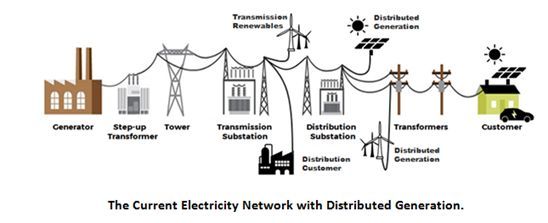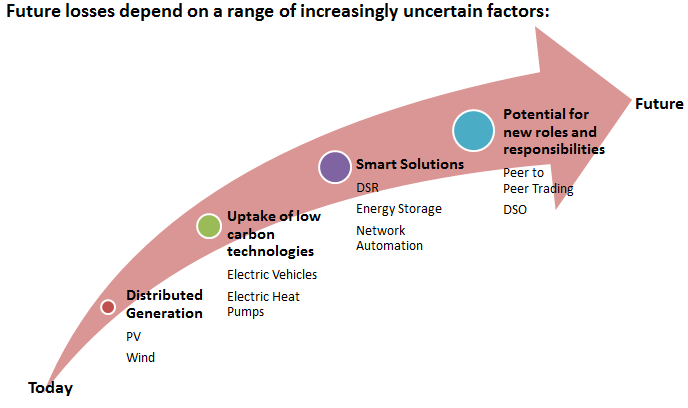Changes to Losses
Traditional power stations are large and centralised; therefore, it is justifiable to connect them directly to the National Grid transmission system. In contrast to this, renewable energy sources tend to be smaller and more distributed around the country; meaning they are usually connected to local distribution networks. This disrupts the traditional flow of power from generators to transmission networks, to distribution networks and then to the customer. If the energy from distributed generation is used locally (and within a suitably short period of time), then this reduces losses.
The images below show the traditional electricity network vs the network that we see today with an increased amount of distributed generation.

A traditional electricity network

Today's evolving network with distributed generation
As National Grid Electricity Distribution (NGED) moves towards a Distribution System Operator (DSO) way of working, there will be a need to manage energy flows across the network to increase utilisation and balance demand and generation. This has the potential to increase losses if power flows increase or demand and generation cannot be balanced. Alternatively, it could reduce losses if the network was perfectly balanced. Work completed for the ENA Technical Losses Working Group by WSP has shown that losses could increase as a result of DSO flexibility, but this is something that must be closely monitored and evaluated in relation to the cost of losses vs the cost of reinforcement.
During RIIO-ED1, DNOs began publishing a Losses Strategy as required by Ofgem. This recognised the need for an evolving approach to losses, which will be affected by the network changes associated with the UK target of net zero by 2050:
Renewable Energy: Unlike fossil fuels, renewable energy generation like wind and solar are usually smaller and more widely distributed around the country. Consequently, they may be connected to the local distribution network rather than the central transmission grid. Having power enter the network at lower voltages substantially changes the way power flows across the network. In many cases, it can lead to an increase in losses.
Uptake of Low Carbon Technologies: Due to government targets, we expect that there will be a substantial increase in the uptake of low carbon technologies. This will substantially increase demand on the electricity network. When demand increases, currents will increase, and due to the nature of losses, when the current increases, so does the level of losses.
Smart Solutions: Some of the smart solutions that we see in the energy sector, including demand-side response, energy storage and network automation, will all lead to higher utilisation of the network which, in turn, will lead to higher losses.
New Roles and Responsibilities: Peer to Peer trading and the work of the Distribution System Operator will again lead to higher utilisation of the network which in turn will lead to higher losses.

Under our License Conditions, we must keep losses ‘as low as reasonably practicable’. However, we also have a responsibility to offer our customer’s value for money and to develop our Distribution System Operator services, including the use of flexibility to defer reinforcement. We must therefore monitor losses and manage them in relation to our cost-benefit analyses to find the right balance between losses and costs. You can read more about our losses management approach here.
